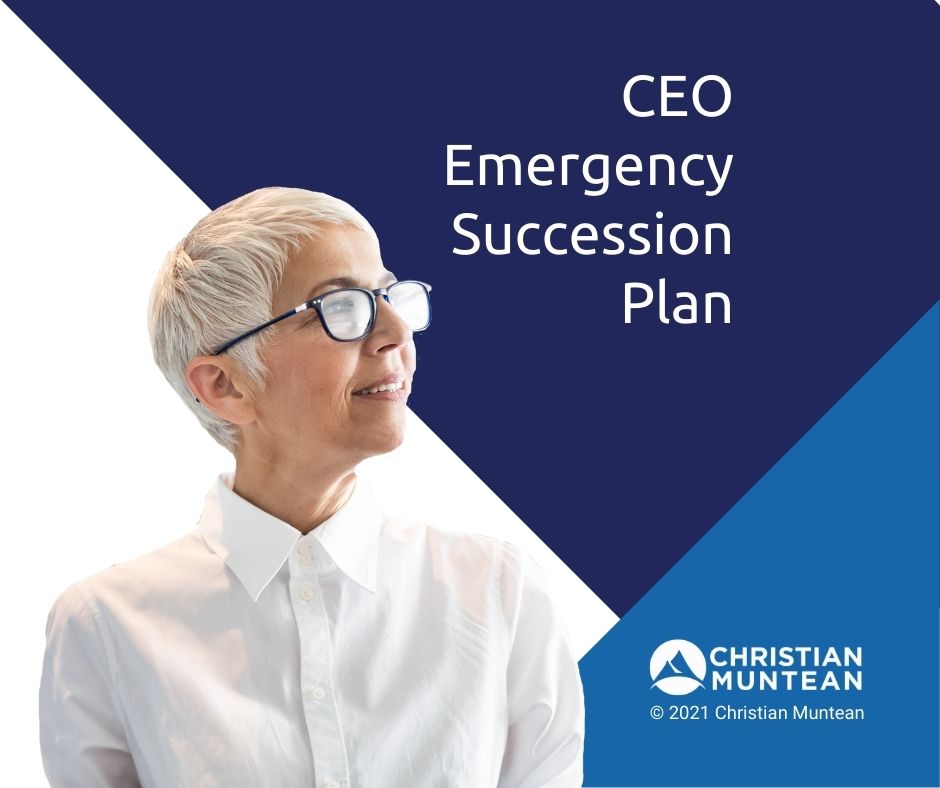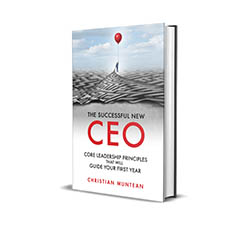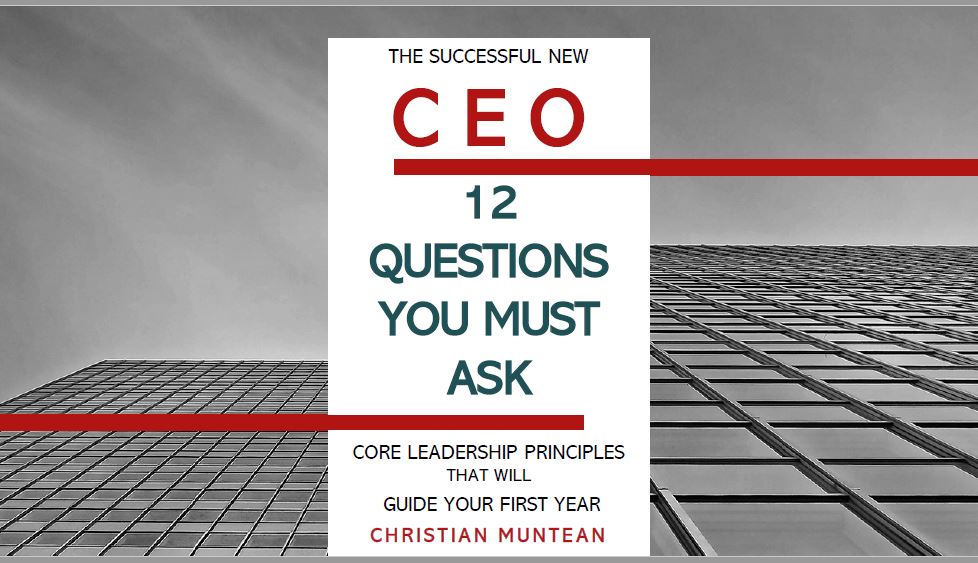The “Make It Easy” Tool for Identifying Your New CEO

 This is the fourth article in a short series on executive succession planning. We are following Western Manufacturing’s board and senior management team as they plan for their founder William’s succession. They have completed the major steps of 1) Defining their values & and a five-year operating vision, 2) Creating a rough sense of what the company will need to look like in five years to meet that vision, and 3) Identifying key areas in the company that should be stabilized before a succession occurs. Now having defined what will be led, they are ready to create the last part of their plan: To describe the qualities of an ideal successor. If you’d like to start the series from the beginning, click here.
This is the fourth article in a short series on executive succession planning. We are following Western Manufacturing’s board and senior management team as they plan for their founder William’s succession. They have completed the major steps of 1) Defining their values & and a five-year operating vision, 2) Creating a rough sense of what the company will need to look like in five years to meet that vision, and 3) Identifying key areas in the company that should be stabilized before a succession occurs. Now having defined what will be led, they are ready to create the last part of their plan: To describe the qualities of an ideal successor. If you’d like to start the series from the beginning, click here.
Carla returned to the conference room after a break. It had been a month since the initial succession planning workshop. The team had agreed to meet monthly to check in on action items. Today was the first monthly meeting. Her feelings were mixed.
The first half of the meeting had been dedicated to progress checks on action items assigned the previous month. Progress had been made. But not as much as anyone hoped. They took time to recalibrate their goals for the coming month, but now with a sense of concern.
“This is pretty normal,” Adrian, their consultant, said. “Most teams start with high ambitions. But then the day-to-day intervenes. It’s important to set aside time to work on these topics – as they never tend to feel urgent.” As the team discussed this, they decided to take five minutes right then to address it. They opened up their calendars and scheduled “appointments” with themselves to work on their action items over the next month.
Adrian continued, “OK, team, you’ve done a lot of hard work so far. You are gaining an appreciation for the work that remains. I want to encourage you that most of this work isn’t time-consuming. It’s just new and unfamiliar. It includes important decisions and this can make it appear difficult. But as you get into it, I think you’ll find that most of it isn’t that hard to do. But it does take doing.
Now we’re going to get into the part of succession planning that probably looks more like what you expected at the beginning. Except now, I think you’ll find yourself much more prepared.”
Values and Vision: True North for Succession Planning:
Adrian reviewed their new values and vision statement with them. “Last month, you defined your values as Integrity, Quality Craftsmanship, Reliability, and Creativity. Do these still sound right to you?”
The team looked up. Most of the team either smiled or nodded as they were read. Simply hearing their values seemed to reenergize them.
“Ok, then we’ll keep them. You defined your operating vision for the next five years as, ‘Western Manufacturing “owns” the tri-state market and is recognized as a national leader in your industry – specifically in the area of combining environmentally and economically sustainable manufacturing practices. To do this we’ll need to acquire portions of your supply chain and add an additional plant/distribution center that is located in a major shipping hub.’ Does this still sound right to you?”
Again, the team smiled and nodded.
Tim, VP of Business Development, spoke up, “The operating vision seems wordy. Shouldn’t we make it shorter? And do we really want to put that on our website?”
“Great questions, Tim,” answered Adrian. “The answers are no and no. The purpose of this operating vision is to guide your decision-making. It needs to be clear and descriptive enough to do that. That’s it.”
“Feel free to wordsmith it for external communication, like marketing. Just remember that most vision statements get wordsmithed into meaninglessness. This one is designed to help you create and maintain your focus. Change it if you want – but don’t lose the clarity. In fact, it’s fine to have a descriptive one used internally and a ‘prettier’ one for your external communication – as long as both are aligned.”
“Putting it that way, I think it’s fine,” said Tim.
High Standards Work Better
“Ok then. As we step into describing your ideal successor, your values and vision are the primary filters you’ll use. You want someone who will fully embody your values and be more than able to lead the company into your vision.”
Stephanie, the HR director asked, “I understand this, but it seems to be a really high standard. It’s so hard to find employees as it is. Is this realistic?”
“Thanks for bringing that up Stephanie,” said Adrian. “It is a high standard. And we’re actually about to make the standard even higher. Ironically, a high standard will actually make it easier for you to identify the successor. Not harder.”
“There are a couple of reasons for this:
- First, if you are clear about who you are looking for, it’ll be easier to recognize that person. There will be less doubt or potential disagreement about your choice.
- Second, clarity about your values and vision, along with any other expectations, work like magnets. They attract people who “fit” with you and identify with what you say you are looking for. High achievers, especially, understand that they have something to offer. They are looking for a company that is a good match for them. The better you can describe yourself and your standards – the more it functions as a magnet – attracting the kinds of people you want.
In fact, if you apply this process to all of your hirings, you’ll find that you’ll attract more ideal candidates for any position in your company. Does that help, Stephanie?”
Stephanie nodded. She looked interested if not entirely convinced.
The Leadership Selection Funnel
“Ok. Let me introduce you to The Leadership Selection Funnel.”
Step One: Describe the Ideal Leader
“We’ll begin by brainstorming all of the characteristics that you would like in an ideal CEO. Don’t even worry if it seems unrealistic that one person might have ‘all of this.’ Just create a list of what you’d like to have in a leader.
It’s helpful to use these broad categories to stimulate thinking.” Adrian walked up to the dry erase board, divided it into quadrants, and wrote one of these words in each quadrant: Perspectives, Experience, Expertise, and Competencies.
Adrian continued, “For Perspectives, we want to reflect on what viewpoints might be valuable in this position. This may include:
- Demographics: Does gender, age, ethnicity, or socio-economic background factor into their ability to lead this vision?
- Cultural: Does it help if they come from/have they lived in this region. If they have an urban or rural perspective? Do their values and background mesh well with our culture? Do they already understand our employees or our customers?
It may also include their Experience. What kind of experiential background would be ideal?
- Should they have demonstrated success as a CEO already?
- Should they have demonstrated success with the skills needed for this role?
- What has their relational experience been like – how have they typically related to others?
- How have they handled conflict or difficult challenges in the past?
This also includes their Expertise: What skills or credentialing should they have?
- Are there any licenses, degrees, or certifications that matter?
- What about areas of technical or topical expertise?
Last, let’s consider their Competencies: What are they able to do? For example:
- Can they think and lead strategically?
- Are they able to communicate clearly?
- Are they able to effectively prioritize and manage time?
- Are they able to network well?
You can add or amend categories as you see fit.”
Adrian then led the group through a process to gather their ideas around each of those quadrants. He clustered similar-sounding ideas together.
Step Two: Build the Funnel – Prioritize Traits
“Good work team! Now you are ready for the next step. Let’s take all of the traits we’ve identified and divide them among the following categories:
- Must-Have Traits: Any candidate worth considering must have all of these traits. These are the non-negotiables. Interested parties need not apply if they don’t fulfill these minimums.
- Elective Traits: Remember college? You had to pick 3 of the following 5 class options? Same here. This is where you put all of the traits that are of high importance but are not Must-Haves. List them all and decide what is the minimum number of elective traits a candidate should have. This helps you select between candidates who satisfy your Must-Have criteria.
- Bonus Traits: You can live with or without these traits. But, wow, it sure would be nice if a new CEO had these. That’s where these traits go. They help you select from the people who have the Must Haves and also have sufficient Elective Traits. There might be a few choices left over. Bonus traits help filter them out.”
Adrian then led the team through another exercise to assign a priority to their original list. Along the way, a few new qualities were identified. Some were even combined.
Step Three: Recruit – Hire a recruiter, advertise, brainstorm
Adrian continued, “Now you know what you are looking for. This should be handed off to your selection committee. In your case, this is your entire board. They can brainstorm who they know within the company or network who might fulfill these qualities. They can use this language to build language for a hiring ad. Also, if you choose to work with an executive recruiter, this work will help speed that process along.”
Step Four: Choose
“The person who matched all of these criteria and is able to lead in alignment with your Values and Vision is likely going to be a rock star for your business.
Looking at this list, how does it help you in terms of moving forward?” Adrian asked.
Ernie, the CFO, said, “This really helps. At first, I couldn’t imagine anyone being able to replace William. In fact, we won’t find another William. But this helps me see that we aren’t looking for ‘Replacement William’ we’re looking for an entirely new person. And now I know what that person looks like.”
Stephanie jumped in, “This is fascinating! I’ve never seen this approach. I can see how this is, in some ways, less about high standards and more about clear standards. I also love how it helps add a sense of humanity to the role – far beyond a typical job description.”
Timeline and Execution
After the rest of the group had an opportunity to chime in, all with similar comments, Adrian brought the meeting to a close, “In terms of succession planning, we are about done. What’s next is implementing the plan. Follow through on this month’s action plans, and begin your recruitment process.
Some additional thoughts about the timeline… If you work with a recruiter, it’ll typically take two or three months before they are able to start to bring candidates to you.
Also, after someone is selected, they may need three to six months to leave their current position to come here. You’ll want to give the company at least a few months for onboarding.
Those are ideals. But I say that to remind you of this: William has said he wants to retire by the end of this year. You don’t need to make a rushed decision, but you also don’t have time to dilly-dally.”
Carla thanked Adrian for his help. As the meeting closed, she realized that she felt much more confident about the process and excited about the future of the company. Based on the looks on the faces of others, it appeared that they did as well.
Now, they just needed to follow the plan.
Summary
- Use the leadership selection funnel to help identify candidates. This saves time and creates alignment within the team. If considering internal candidates, it helps reduce potential conflict and make the ideal candidate more obvious to all involved.
- The recruitment, selection, and onboarding process typically takes between six to eighteen months. Act accordingly.
This article is part of a short series on succession planning. In the next article in the series, we’ll watch as Carla and the rest of the board at Western Manufacturing create a selection team and process that has credibility throughout the entire company.
Take good care,
Christian
𝗧𝗵𝗲 𝗕𝗲𝘀𝘁 𝗧𝗶𝗺𝗲 𝘁𝗼 𝗖𝗿𝗲𝗮𝘁𝗲 𝗔𝗻 𝗘𝗺𝗲𝗿𝗴𝗲𝗻𝗰𝘆 𝗦𝘂𝗰𝗰𝗲𝘀𝘀𝗶𝗼𝗻 𝗣𝗹𝗮𝗻 𝗶𝘀 𝘽𝙚𝙛𝙤𝙧𝙚 𝗬𝗼𝘂 𝗡𝗲𝗲𝗱 𝗜𝘁.
Be prepared for a smooth transition in the event of an unplanned emergency succession. My guide will show you step-by-step how to devise your own plan.
Free Leadership Resources
Whether you are a new CEO, thinking of succession or exit, or wanting to strengthen your leadership and your team, I’ve got resources to help:
Enhancing your leadership skills
Are you interested in learning more about becoming a successful CEO? If so, get a free copy of my book The Successful New CEO. Not a new CEO? I’ve been told by “old hands” that they felt any CEO should read this. So, click here to get your copy today.
by “old hands” that they felt any CEO should read this. So, click here to get your copy today.
Let’s connect.
I’m passionate about helping leaders to create workplaces they love going to and increasing the value of the services they offer. My results-oriented approach is tailored to each client’s specific situation and needs. As a leadership coach, I have developed a wealth of resources to help you and your team grow and become stronger.
Weekly Newsletter – sign up to receive my weekly articles addressing critical leadership challenges and issues.
The Leadership Coach Podcast – In my podcast, we explore effective, high-impact, and enjoyable leadership. Subscribe.
There are 𝟭𝟮 𝗰𝗿𝗶𝘁𝗶𝗰𝗮𝗹 𝗾𝘂𝗲𝘀𝘁𝗶𝗼𝗻𝘀 to ask before accepting a new CEO position. Do you know what they are? Instantly download my free e-book here.
Find the value of your company with my free assessment tool: The Value Builder System
The Value Builder System™ is a 13-minute online questionnaire that evaluates your business on the eight factors that contribute more to its attractiveness and value. These factors are scored on a scale of 1-100. Businesses that score over 80 are likely to command 70%-100% higher value than others.
Opportunities
Executive and Leadership Coaching: Do you feel overwhelmed? Are you not getting the results you expect from the effort you are putting in? Do you find yourself facing similar challenges time and time again? Would you like to change specific ways of relating or reacting? If you would like to experience predictable, measurable growth Contact me.
Profitable Exit Strategy Workshop: Are you a business owner or partner? Over 55? Starting to think about exiting your business or active management in the next 3-5 years?
- Curious about what your business might be worth?
- Would you like to discover the specific steps you need to take to increase its value and become highly attractive to a buyer?
- Are you planning on handing it over to family or employees and you want to ensure long-term success?
If so, contact me now
Article Categories
Popular articles

Download my free 10-page eBook:
How To Accomplish More Without Doing More:
Eight Proven Strategies To Change Your Life
Discover how to save eight hours during your workweek-even if you're too busy to even think about it. The resource every maxed out executive needs.

